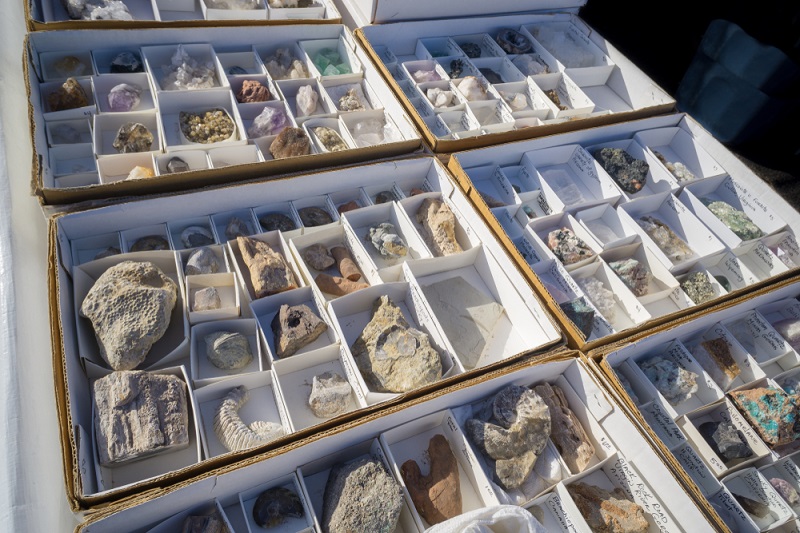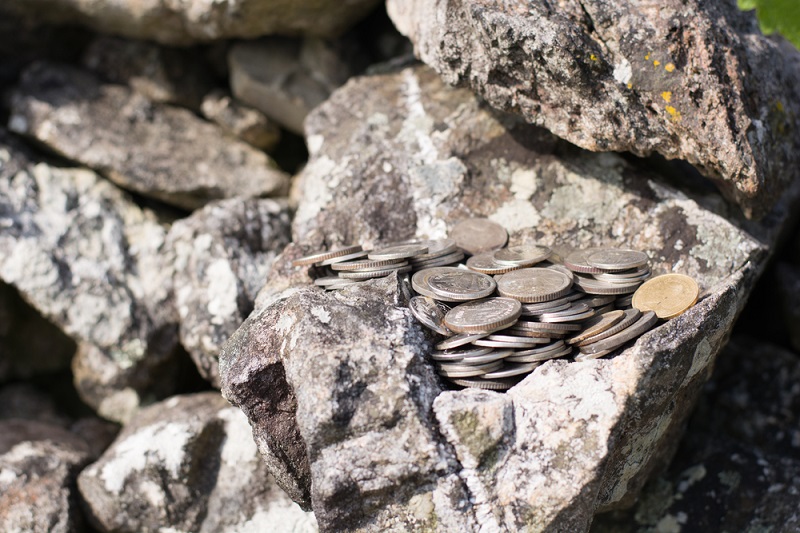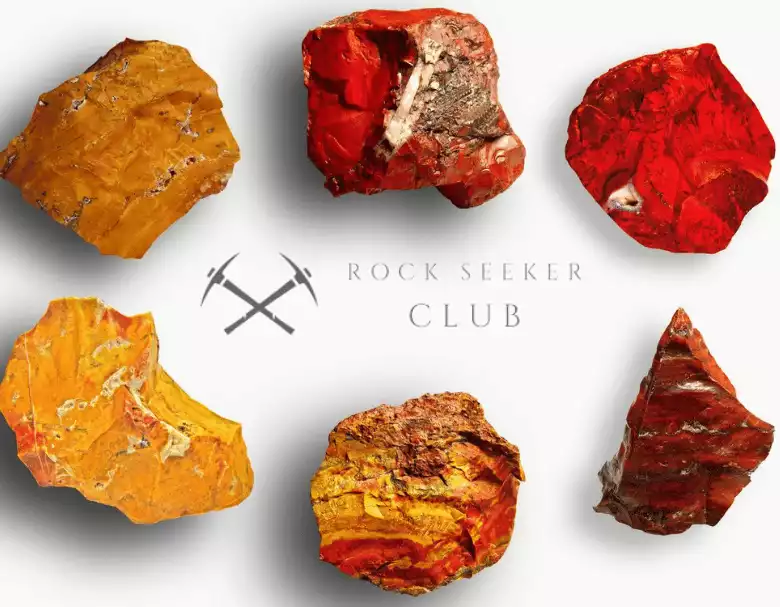Selling Rocks: How To Make Money As A Rockhound
If you are brand new to selling the rocks and minerals that you’ve collected over the years, mindat.org has some tips for those looking to sell their collection online. Perhaps you’ve been the recipient of an inherited rock collection from a family member and you have no idea what to do with them. Well here are some tips to follow to help with the organization and process of selling the rocks and minerals and getting the most value from them.
In this guide, you’ll find a number of different ways you can profit from your rock and mineral collection. Selling rocks isn’t difficult, but just like anything else, you want to try and get the most value from the collection.
But first, you need to get an overall idea of what your rock collection is worth.
Get a General Value for The Rocks and Minerals in Your Collection
It is important to have some idea of what you have and what it is worth. You will have to learn as much about your collection as possible. Mcrocks has good advice on how to accomplish this task. This is the advice that they give:
Join a Rockhound Club
If you have a sanctioned rockhounding club near where you live, you should join. There are mineralogical societies that provide area maps to make it easy to locate any clubs in your geographical area. Not sure where to find a club? RockTumbler.com has compiled a massive list of clubs by state. Check it out here!
Find a Rock Message Board Group
Joining a message group provides an opportunity to learn from other people’s specific questions and posts. You can ask questions of your own. There will be opportunities to join field trips and events.
Rock and Mineral Field Guides are Very Helpful
There are two types of guides. A regional field guide will direct you to where you can collect rocks and minerals. Mineral Identification Key II will help you identify the rocks and minerals you have collected or inherited.
Learn the Basic Rock and Mineral Identification Process
You can develop a systematic approach to identifying your collection based on hardness, luster, streak, cleavage and other characteristics. Online resources such as the Mineral Identification Key II can help you identify minerals you may be unfamiliar with. It lists all the most common minerals as well as those that are less known.
Be Careful of Commercial Operations That Advertise Inflated Gem and Mineral Values
These may be an attempt to draw in customers. You have to be systematic and educated in the selling process to make a profit from rock collecting as a hobby.
Use a Photograph that is a Representation of the Whole Collection
Provide a general outline of the collection and post it on a few mineral sites or in a commercial area you are considering. You will most likely get a few bad offers, so don’t take the first one you get. Be patient and get feedback from other rock collectors as to marketing strategies and places to advertise.
Organize and Prepare Your Rock Collection To Sell

First, make a plan to set aside time where you can work on your collection, identify, organize, label, and photograph each piece.
There are several ways to accomplish the organization of your collection. Using index cards, mineral labels, organized box compartments, computer files, etc are just a few examples.
Label The Rocks
If you inherited a collection from a previous owner and the specimens are labeled, these labels are going to be extremely important and can add a lot of value to the collection if the original labels are present.
Photograph Each Specimen
Photos are extremely important if you’re going to try selling your rocks and minerals to a buyer online. Your photograph will be much more effective than simply stating or listing a mineral with no visual at all. As a matter of fact, you probably won’t ever even get a response from a prospective buyer without a photo. It’s that important to the buyer as it is simply impossible to judge the value of the specimen without seeing it.
Catalog Each Piece of The Collection
Here is a process you can use to record your rock and mineral collection:
- Decide on your method of cataloging your collection
- Number the collection and make sure your photos coincide with the number on the mineral (if your mineral number is 1, the photo should be called 1.jpg)
- Record your collection to a spreadsheet and include any old letters, your new numbering system, locality, size, notes, and leave a column for the purchase price
- When photographing, write the mineral number on a sticker and attach to the bottom of the specimen, take macro photographs from 3 different angles
- Make sure the number is included in a photo
- Take measurements in 3 directions in centimeters
How To Sell Your Rock Collection (Tips For Selling Rocks and Minerals)

1. Sell To A Rock and Gem Dealer
Mineral dealers vary greatly in what they are willing to offer. Some will offer you the lowest value for the minerals while others will offer a much fairer price. So your first job is to research the mineral dealers in your area.
If you’re lucky, you’ll find a good one who is located close enough to you who is willing to buy the collection in person. You should make the requirement ahead of time that the collection sells as one package. The last thing you want is for a dealer to come to pick out the good stuff and leave you with the rest to try and sell at a later date. Believe me, you’ll have a much more difficult time selling those leftover specimens.
2. Selling Your Collection as Individual Pieces
If you have a solid understanding and knowledge of what the specimens are in your collection, then you might find it best to sell each piece individually. You can do this by listing each peice with a dealer or selling on sites like Craigslist or Ebay.
But first, you’ll need to organize your collection. Read the section on how to organize your collection above for more info.
Once you have your rocks, minerals and gemstones cataloged and organized, it’s time to post your information and photos on knowledgeable and reputable websites.
Upload the photos and information of the specimens you’re getting ready to sell so the information can be disseminated to the mineral community. Many forums have resources to help searchers find what they are looking for and link together the rockhound community.
Lastly, have an idea of the going rate for what you are trying to sell. You can look on finished auctions, eBay, or ask you rock community specific questions about price if you’re unsure.
3. Sell to a Rock Shop
Ideally, if you found a local rock shop to do business with, this would be a great source of selling your collection. This is a very common way to sell rocks for part-time rock hunters. You can easily search for a local rock shop and establish a relationship. If you are reliable in what you present and trust the shop is offering a fair price for your rocks, you have found a “win-win” situation.
Rockhoundworld reminds us, however, that selling online is going to get the most for your rocks, but there is a lot of work and preparation involved in posting and selling online. You will reach a broader audience of people that are specifically looking for what you are selling. While a local rock shop will most likely offer you a wholesale price. Just keep in mind that they need to buy low in order to make a margin of profit when they resell the rocks.
If you are located near a city, you can research larger rock shops that may be located near you. You’ll probably not get the price you were hoping, but they may have a broader scope of the types of rocks and minerals they will buy.
But if you’re wanting to sell your rock collection fast, and aren’t necessarily concerned about getting the most value out of the rocks, then selling to a local rock shop is going to be your best option.
4. Set up Your Own Rock Shop
If you have a solid collection and want to take your rock collecting to the next level, you can always start up your own small rock shop or business. Although doing something like this may require a lot more leg work, you’ll have the option of operating the hours you want as well as selling directly to the public.
Find A Gap in The Market
If you find that there’s local competition, get to know what they offer and at what prices. Try to gear your inventory to offer what they lack and fill in those gaps.
Sell At Flea Markets
When owning your own rock shop, you can set up shop at local flea markets. Doing this allows you to display all your products to a large selection of potential buyers, all on your schedule. This kind of flexibility allows you to replenish your stock as needed without dealing with unnecessary time constraints.
Set Up Shop In Your Home
Save money by setting up a shop in your own home. There are many rock and mineral collectors that turn a part of their house into an actual small rock shop.
The main consideration in doing something like this is that you stay very organized and are capable of running a real business. You’ll need to establish consistent hours of operation, have a good inventory, know the zoning ordinances and be in a location that has lots of potential customers.
Perform a Basic Market Analysis
Before opening up a rock shop at home to sell rocks, I highly recommend that you perform a very basic market analysis to establish if your area is a good location for a rock shop. You’ll be able to use the information you obtain to determine the size and selection of the inventory you’ll need to open your shop and be successful.
Tips For Displaying Rocks and Minerals To Sell
As with selling anything, the presentation of your product is key. Here are a few tips on how to display your rocks, minerals and gemstones to sell:
- Rocks and minerals sell better when they are in an impressive display. If you have anything that shines, make sure it is presented in good light to catch a customer’s eye.
- Build display cases around your rare or unique pieces. This raises the value and brings interest to the other surrounding stones.
- Use signs to list the properties and benefits of the stones for alternative uses. Many people are now looking for stones for holistic and meditative purposes.
- Allow potential buyers to see the value of your rocks as design items. List the possible uses of rocks for your customers and create displays like filling vases, adding to aquariums, as a base for plants, bookends, etc.
5. Lapidary
If you are a creative type, you can always consider breaking into the lapidary business. InThis will give you the opportunity to create jewelry and other fine wearables out of rocks and minerals that you find. The DIY process of creating interesting and saleable jewelry is becoming increasingly popular. It’s a fun and simple process to turn your rock finds into a product you can sell online or in a small shop.
Here is an excellent introduction to the lapidary arts that Gemsociety.org has put together.
Final Thoughts
These are just a few different ideas and ways you can do to sell rocks. Some of the easiest and fastest ways to sell rocks and minerals is simply by word of mouth and talking with other rockhounds. If you want to connect with other people that love rocks as much as you do, consider joining the RockSeeker Facebook group!
- 7 Of The Largest Gold Nuggets Ever Found…Ever! - December 21, 2023
- Find Gold On Your Property? Here’s Why You Should Think Twice Before Spreading the News - December 21, 2023
- The Opalized Crab Claw (And How It Formed) - September 14, 2023
- Online rock and mineral club for collectors of all levels!
- Find community with like-minded rock and mineral enthusiasts.
- Monthly Giveaways!
- Free Access to Entire Digital Library of Products (annual memberships)


